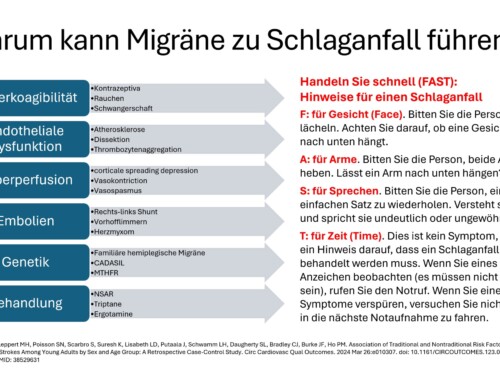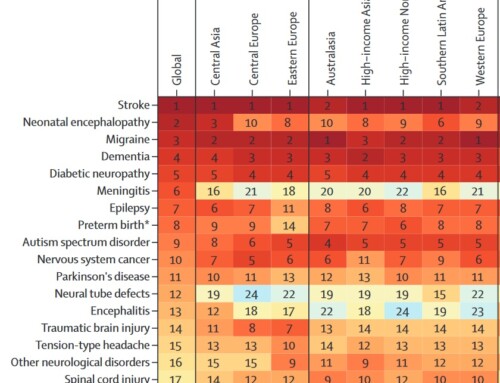New research suggests that migraine is an energy deficit syndrome of the brain with dysregulation of energy turnover in the mitochondria of nerve cells. This leads to a cascade of neurological symptoms. Using magnetic resonance spectroscopy (MRS), numerous substances that are involved in energy metabolism could be analyzed. These include lactate, magnesium and adenosine triphosphate. Studies have identified changes in the hypothalamus, thalamus, and brainstem. These suggest an endocrine origin of migraines. Taken together, these studies suggest that the migraine attack itself is a response to an energy deficit syndrome in the brain.
Oxidative stress levels exceed the antioxidant abilities of the nerve cells. The migraine attack may help restore the brain's balanced energy balance. It reduces damaging oxidative stress. Nerve cells maintain their ability to neutralize reducing or oxidizing substances by producing and storing oxidizing or reducing substances. If the normal repair and detoxification function of a cell is overwhelmed, this is called oxidative stress. The result is incorrect control or damage to cell function.
Dysregulation of mitochondrial enzyme function and glucose metabolism as well as oxidative stress may be specific responses to external triggers. This leads to migraine attacks in patients who have a cerebral overreaction to external stimuli and result in a dysregulation of central stimulus processing.
Triggers or triggers do not work in themselves. Rather, their effect is a result of disruptions in the brain's energy metabolism. The decisive factor in the development of a migraine attack is not the attack itself. Rather, this occurs as a result of a variety of events, often weeks before the actual attack occurs. These events then culminate in a migraine attack. The immediate period before the actual attack is therefore not of crucial importance. The advice to avoid triggers usually doesn't work. They work at certain times and not at other times. Triggers culminate in a migraine attack when a certain threshold is exceeded, which is determined by the biology of those affected, but not by the physical properties of the trigger. The common factor of the triggers is their ability to cause oxidative stress. Oxidative stress is caused by a deficit in nervous energy reserves. The result is that the nerve cells can no longer use their energy to defend themselves against oxidative stress and the antioxidant defense is no longer sufficiently possible. These changes are then reset to the normal situation by the migraine attack.
These findings result in a completely new approach to the treatment of migraines. In particular, therapeutic intervention can be carried out through knowledge and adapted behavior well before the actual onset of the migraine attack. This calls into question the previous thinking that the migraine attack is the actual illness that needs to be suppressed. Rather, the migraine attack is an attempt by the brain to re-stabilize the energy balance and restore physiological functioning.
This results in new, essential preventive treatment strategies. Treatments that normalize brain metabolism play a central role. Measures that aim to stabilize energy metabolism should therefore primarily be the focus of therapy. This applies to adults, but even more so to adolescent patients and children.
The focus is also on nutrition. It provides the energy and the ability to work to the nerve cells. Nutrition is the key to ensuring adequate energy supply to the central nervous system. Regularity and a diet rich in carbohydrates are the central rules for a stable energy supply to the nerve cells. But stabilizing the energy balance can also be important for the treatment of the acute attack. Caffeine activates the energy conversion from carbohydrates into nervous energy. Corticosteroids can also have a therapeutic effect on the energy balance of nerve cells through a metabolic effect. All other treatment methods for attack therapy work by reducing pain generation in the trigeminovascular system, which was previously activated by metabolic changes with an energy deficit.
All in all, the migraine attack is a protective reaction of the brain to ward off damage and not the actual problem. Through the migraine attack, the body tries to stabilize the energy balance after a massive disruption of the metabolic system with an energy deficit.
Professor Dr. discusses how you can actively keep your energy balance in balance through diet and behavior. Hartmut Göbel with the well-known NDR nutrition doctor Dr. Matthias Riedl, Medical Director of the medicum Hamburg, about living with migraines as painlessly as possible.
The expert discussion is reproduced in the magazine “Iss Dich Gesundheit”. Read the details in the attached PDF.
Eat healthy: nutrition for migraines
literature
1. Gross EC, Lisicki M, Fischer D, Sándor PS, Schoenen J. The metabolic face of migraine – from pathophysiology to treatment [published online October 4, 2019]. Nat Rev Neurol. doi:10.1038/s41582-019-0255-4
2. Kokavec A. Migraine: A disorder of metabolism? Med hypotheses. 2016;97:117-130.
3. Akerman S, Romero-Reyes M, Holland PR. Current and novel insights into the neurophysiology of migraine and its implications for therapeutics . Pharmacol Ther . 2017;172:151-170.
4. Borkum JM. Migraine triggers and oxidative stress: a narrative review and synthesis . Headache . 2016;56(1):12-35.











Leave a comment